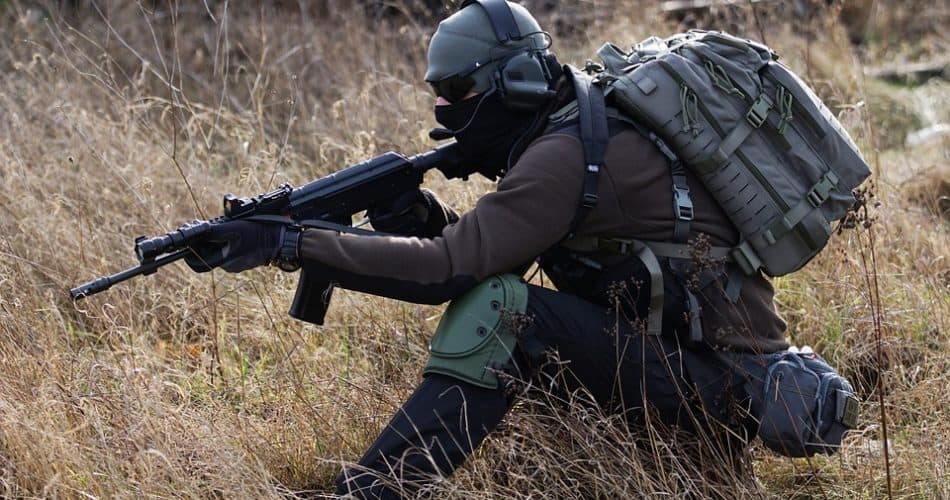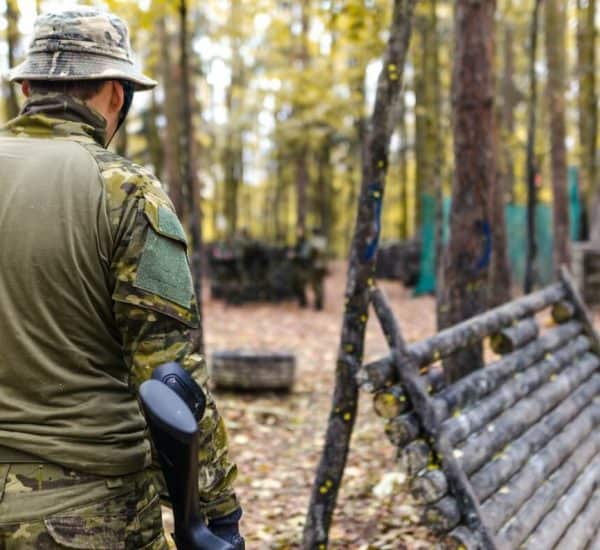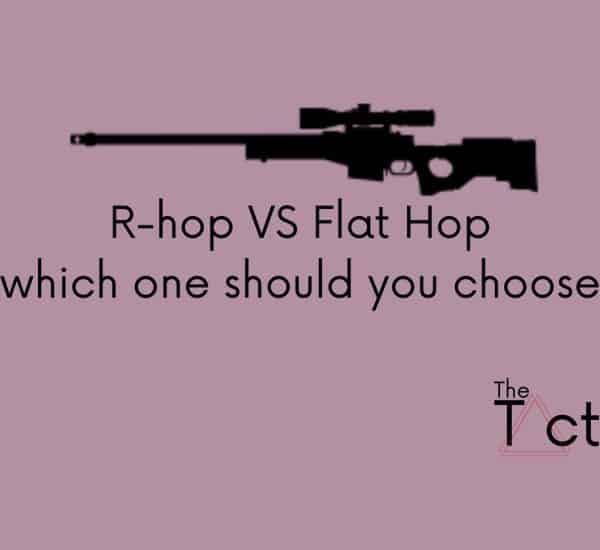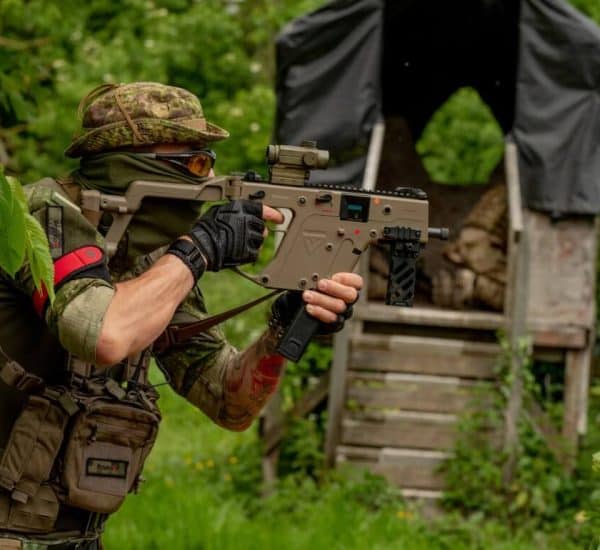Does Airsoft Hurt? Unraveling the Myths and Facts
Introduction
Airsoft, a game of strategy, skill, and precision, has gained massive popularity over the years, drawing enthusiasts from all corners of the globe.
At its core, airsoft is a sport where participants eliminate opponents by hitting each other with spherical plastic pellets launched via replica firearms. These replicas closely resemble real firearms but are designed exclusively for the sport.
For those unfamiliar with the game or contemplating their first experience, one question often rises above the rest: “Does airsoft hurt?” It’s a valid concern, as being on the receiving end of a projectile, even a small plastic one, can be daunting.
Throughout this article, we’ll delve into this question, dispelling myths and laying down the facts about the pain (or lack thereof) associated with airsoft. Whether you’re an anxious newbie or a curious parent, this exploration promises clarity.
A Brief History of the Sport
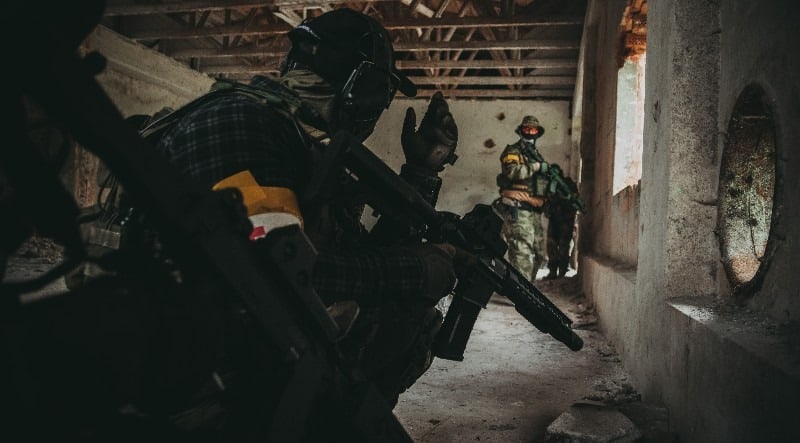
The roots of airsoft can be traced back to Japan in the early 1970s. In a nation where owning a firearm was, and remains, heavily restricted, there emerged a demand for realistic gun replicas. These replicas initially served enthusiasts who wanted firearms for collection or training purposes but couldn’t own the real thing. As a solution, manufacturers developed spring-powered replicas that could shoot plastic pellets. These weren’t intended to be used in sports initially but as a safe training tool or as collectibles.
However, people didn’t take long to recognize the potential for a new kind of competitive sport. With safety gear and regulations in place, enthusiasts began engaging in mock combat scenarios, marking the informal birth of airsoft as a recreational activity.
By the 1980s, technological advancements introduced gas-powered and electric airsoft guns, enhancing the game’s realism and appeal. These innovations fueled the sport’s spread to other parts of Asia and, eventually, to the Western world.
Popularity and Global Reach
From its humble beginnings in Japan, airsoft rapidly garnered a passionate following, eventually reaching countries like the Philippines, Taiwan, and Hong Kong. Its appeal wasn’t limited to Asia, though. By the late 1980s and 1990s, the sport had started to take root in Europe and North America.
Airsoft has a vast global community today, with organized events, tournaments, and conventions held in numerous countries. From outdoor military simulation scenarios in the United States to urban CQB (Close Quarters Battle) games in European indoor arenas, the game’s formats and settings can be as diverse as its players.
Its popularity is also reflected in the rise of airsoft retail stores, online forums, YouTube channels, and other social media platforms dedicated to the sport. Furthermore, airsoft’s emphasis on honor (players are expected to call themselves out when hit), strategy, and teamwork have made it not just a game but a community where camaraderie and sportsmanship are highly valued.
Understanding the Equipment: Airsoft Guns and Pellets
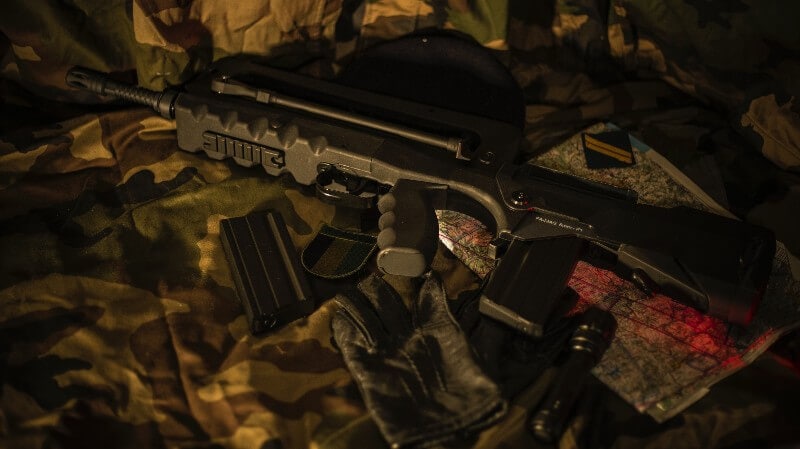
Different Types of Airsoft Guns
Airsoft guns come in various forms, offering different mechanisms and features for specific playstyles and scenarios. Here are the primary types:
Spring-Powered Guns: These are the most basic type of airsoft guns. They rely on a manual spring mechanism. To fire, the user must cock the gun before each shot. Due to their simplicity, they are often more affordable and are commonly used by beginners.
Gas-Powered Guns: These use compressed gas to propel the BBs. The gas, which can be CO2, green gas, or propane, is stored in the magazine or a separate cartridge. Gas-powered guns are popular for realism, offering features like blowback (where the slide moves back and forth like a real firearm).
Electric Guns (AEGs): Electric guns are powered by rechargeable batteries, usually NiMH or LiPo. They employ a motor-driven piston assembly to shoot the pellets. AEGs are among the most popular types of airsoft guns, known for their consistency and ability to offer automatic or semi-automatic fire.
High-Pressure Air (HPA) Guns use externally supplied, highly compressed air. The primary advantage is the ability to adjust the gun’s power easily, offering consistent performance regardless of the external environment.
The Ammo: Biodegradable vs. Non-Biodegradable BBs
Airsoft BBs, or pellets, are typically made of plastic, but their environmental impact can vary:
- Biodegradable BBs: Made from materials that naturally decompose over time, these BBs are designed to reduce environmental impact, especially in outdoor fields where collecting spent BBs is impractical. They are slightly more expensive due to the materials and manufacturing process involved.
- Non-Biodegradable BBs: These are traditional plastic BBs. They are durable and less affected by moisture but can persist in the environment for a long time. Many outdoor fields now mandate using biodegradable BBs to protect the ecosystem.
The Weight and Material of the BBs
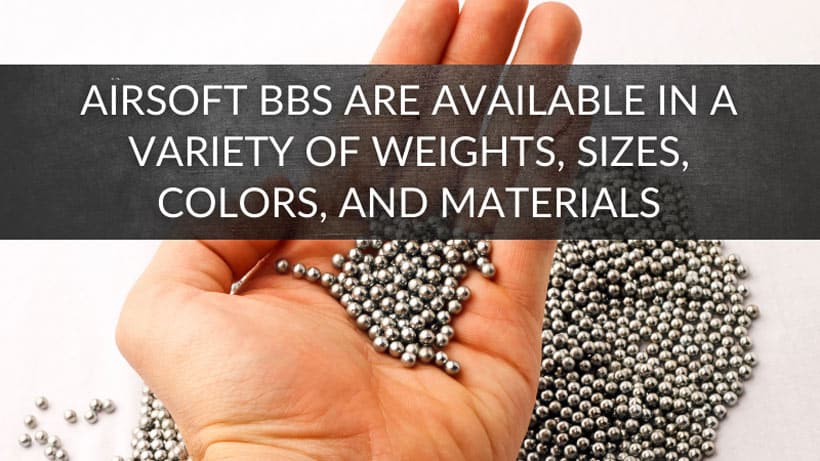
Airsoft BBs generally range in weight from 0.12 grams to 0.43 grams, with the most common weights between 0.20 and 0.28 grams. The weight chosen can affect the pellet’s accuracy, range, and impact force:
- Lighter BBs (e.g., 0.12g): These are less accurate, especially at longer distances or in windy conditions. They are typically used in low-powered spring guns or for casual play.
- Heavier BBs (e.g., 0.25g and above): Preferred by serious players and those with high-powered guns. They offer better accuracy at longer distances and are less affected by environmental factors.
The material is primarily plastic, but variations exist. For instance, some BBs have a ceramic or metal core for increased weight and impact, though these are less common and may not be allowed in standard airsoft games due to safety concerns.
Understanding the equipment is crucial in airsoft. The type of gun and the choice of ammo can significantly impact one’s experience, performance, and the environment. Proper knowledge ensures both enhanced gameplay and responsible participation.
Factors that Influence the ‘Sting’
- Distance: The further a pellet has to travel, the more energy it loses due to air resistance. As a result, a hit from a closer range will usually feel more potent than one from a longer distance.
- Pellet Weight: Heavier BBs retain energy better over distances and are less susceptible to wind and other environmental factors. While they might travel at a slower velocity than lighter BBs from the same gun, they can deliver a more pronounced impact due to their increased momentum.
- Impact Area: Some parts of the body are more sensitive than others. A hit on bare skin, like the back of the hand or the neck, will sting more than once on a padded or protected area. Similarly, direct hits on bony areas like the knuckles or the forehead can be more painful than hits on fleshier parts.
- Clothing and Protective Gear: The type and thickness of clothing or protective gear can significantly reduce the impact sensation. Padded vests, jackets, and specialty airsoft gear can disperse the pellet’s energy, making hits less painful.
- Gun Type and Modifications: Some guns, especially modified ones or those running on high-pressure air, can shoot pellets at a higher velocity, leading to harder hits. It’s essential to be aware of a gun’s power and to use it responsibly, especially in close-quarter scenarios.
While the physics of an airsoft hit is relatively straightforward, the actual sensation is subjective and influenced by various factors. However, players can ensure a safe and enjoyable experience with proper knowledge and precautions.
Comparing Pain: Airsoft vs. Paintball
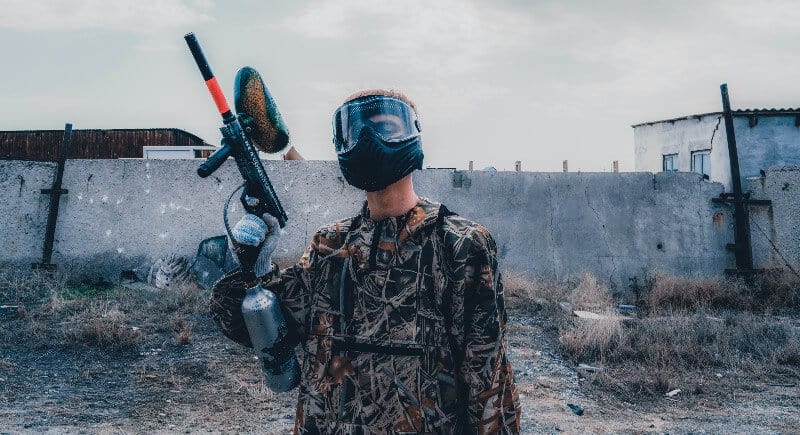
Both airsoft and paintball are beloved recreational sports with large followings worldwide. However, the equipment and the sensation of being hit in each sport vary considerably. Let’s delve into these differences and what players from both realms have to say.
Differences in Equipment
Projectiles:
- Airsoft: Uses small, round plastic BBs that typically range from 0.12 to 0.43 grams in weight.
Paintball: Uses larger, spherical gelatin capsules filled with paint. These paintballs are significantly heavier than airsoft BBs, typically weighing around 3 grams.
Guns:
- Airsoft: Offers a variety of guns, from spring-powered to electric and gas, all designed to shoot lightweight plastic BBs.
- Paintball: Uses specially designed markers that operate on compressed air or CO2 to shoot paintballs. These are typically larger and bulkier than airsoft guns.
Protective Gear:
- Airsoft: Players often wear tactical gear, eye protection, and sometimes mesh masks or full-face protection.
- Paintball: Given the potential impact and mess from bursting paintballs, players usually wear full-face masks, thick clothing, or specially designed jerseys and pants.
Differences in Impact Sensation
- Airsoft: Being hit by an airsoft BB, especially from a distance, is often described as a quick, sharp sting, similar to being snapped with a rubber band. The sensation can vary based on distance, the BB’s weight, and where it strikes.
- Paintball: Paintball hits are generally considered more painful than airsoft. The larger, heavier paintball can leave welts or bruises, especially if it doesn’t break upon impact. The sensation is sometimes likened to being slapped hard. When the paintball breaks (as it’s designed to), the paint acts as a cushion, spreading some of the impact force, but it can still sting significantly.
Real-life Experiences and Testimonies
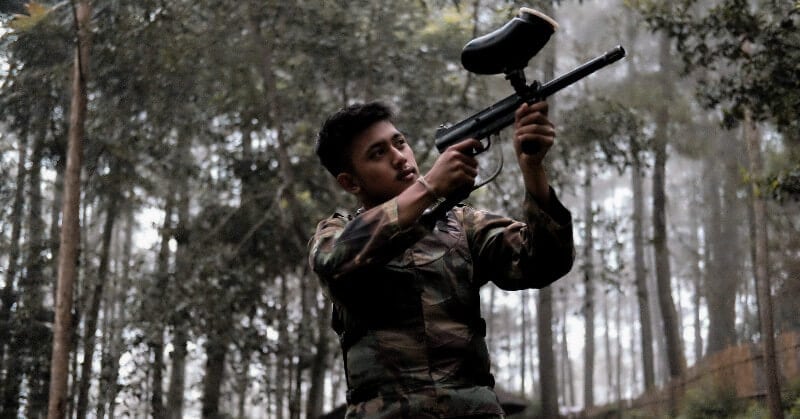
Airsoft Players: Many describe the hits as manageable and fleeting. Some even prefer airsoft because they don’t have to deal with the mess of paint or the larger welts paintballs can leave. “It’s a quick sting that fades fast,” one player remarked.
Paintball Players: While acknowledging the sport can be more painful, many paintball enthusiasts appreciate the visible mark (or splatter) left by a hit, which provides clear evidence of an elimination. “The thrill of the game outweighs the sting of the hits,” said a seasoned player. Another mentioned, “Getting hit can hurt, especially up close, but it’s all part of the experience.”
Cross-players (Those who play both sports): A common sentiment is that while paintball hits hurt more, the adrenaline of the game often makes up for it. One cross-player noted, “Airsoft is like many quick pinches, while paintball is like a solid thump. But in the heat of the moment, you barely notice.”
While airsoft and paintball come with their own pain, they also offer unique and exhilarating experiences. Their choice often boils down to personal preference regarding gameplay style, equipment, and pain tolerance.
Areas of Impact: Where Does it Hurt the Most?
Being struck by an airsoft BB can vary in sensation based on where it hits. Some areas are more sensitive than others, and understanding these can help players be more prepared and take necessary precautions.
Headshots: The Risks and Sensations
Forehead and Scalp: These areas can be particularly painful due to the thin layer of skin and proximity to the bone. An airsoft pellet’s impact can feel sharp and intense.
Eyes: This is a critical area of concern. A direct hit to the eye can lead to serious injury, including blindness. It’s imperative always to wear impact-rated goggles or full-face masks during play.
Ears: A hit on the ear can be excruciating due to its sensitivity. Sometimes, it can also lead to ringing or temporary hearing impairment.
Torso, Arms, and Legs
Chest and Back: These are large target areas but tend to be less sensitive due to the muscle and fat present. While a direct hit can still sting, especially at close range, it’s usually more bearable than hits on bony or sensitive areas.
Arms and Legs: Hits on the fleshy parts of the arms and thighs are generally tolerable. However, direct impacts on bony areas like the elbows, shins, or knuckles can be more painful.
Sensitive Areas to be Cautious of
Neck: The neck is vulnerable due to its exposed position and the presence of vital structures. A hit here can be very painful and potentially dangerous.
Hands and Fingers: These areas have a lot of nerve endings, making them extremely sensitive to hits. It’s not uncommon for players to feel a sharp, burning sensation when struck here.
Groin: As one might imagine, this is an extremely sensitive area for players, especially males. A direct hit can be agonizing and debilitating, even temporary.
Joints: Areas like the knees, ankles, and wrists, where bone is close to the surface, can be particularly sensitive to hits.
While the sensation of an airsoft hit varies from person to person, certain areas are universally recognized as more sensitive. This knowledge underscores the importance of wearing appropriate protective gear, including helmets, gloves, and padded clothing.
Players should prioritize safety for themselves and their opponents by aiming away from the face and other vulnerable areas and respecting game rules and guidelines.
The Role of Protective Gear
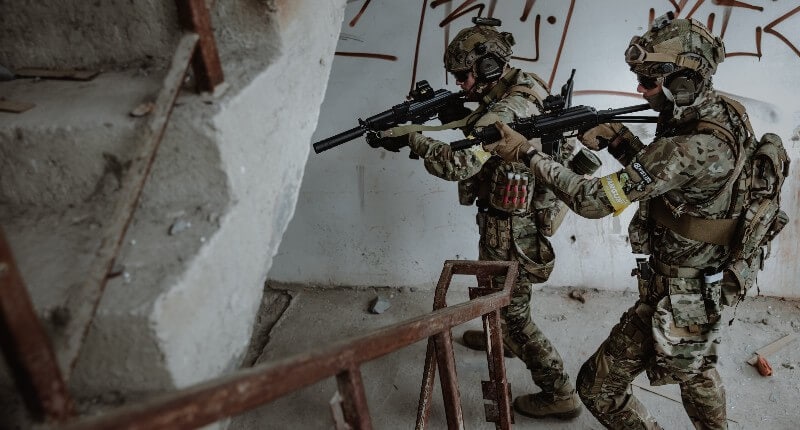
Protective gear plays a pivotal role in ensuring player safety, comfort, and overall enjoyment when engaging in airsoft games. Not only does it protect players from potential injuries, but it can also significantly reduce the sting or pain of incoming BBs.
Essential Gear Every Player Should Wear
Eye Protection: Arguably the most crucial equipment, impact-rated goggles or shooting glasses are mandatory to prevent serious eye injuries. Full-seal goggles are recommended to protect BBs from entering from the sides.
Face Protection: Full-face masks or a combination of goggles and a lower face mask (often mesh) help shield the face from BBs, protecting sensitive areas like the lips, nose, and teeth.
Head Protection: While not always mandatory, wearing a helmet or hat can prevent painful headshots, especially to the scalp and forehead.
Gloves protect the hands and fingers, which are particularly sensitive to hits. Tactical gloves or padded gloves are ideal.
Footwear: Durable boots with ankle support are crucial for protection from BBs and navigating the uneven terrain often found in airsoft fields.
Padded Clothing: Thick clothing, vests, or specially designed airsoft jackets and pants can absorb some of the impact, reducing the sting of a hit.
How Gear Minimizes the Pain
Protective gear is a barrier between the player’s skin and the incoming BBs. By dispersing the kinetic energy over a larger area or by absorbing some of it, the gear prevents that sharp sting one might feel from a direct hit on bare skin. For example, a thick padded vest can turn what might have been a painful hit to the chest into a mere tap.
The Importance of Quality and Proper Fit
Quality: Investing in high-quality gear ensures better protection. Quality gear is often made of more durable materials, provides better coverage, and is designed to absorb and disperse energy more efficiently. Moreover, it’s likely to last longer, making it a worthy investment for regular players.
Proper Fit: Gear that fits well offers better protection and ensures comfort during play. Ill-fitting goggles can fog up, a loose helmet might shift upon impact, and oversized gloves can impair dexterity. Conversely, overly tight gear can restrict movement and become uncomfortable over time. Therefore, players should always try on gear before purchasing or buying from retailers with good return policies if shopping online.
Protective gear is a fundamental aspect of airsoft. Beyond just abiding by field safety regulations, it ensures that players can focus on strategy and fun rather than potential injuries or discomfort. Properly equipped players are safer, more confident, and can enjoy the game fully.
Safety Protocols in Airsoft Games
Airsoft, like any sport, comes with inherent risks. However, with the proper safety protocols, these risks can be significantly minimized, ensuring a fun and safe environment for all participants. The airsoft community’s culture of honor and integrity further emphasizes these rules’ importance.
Standard Rules to Prevent Injuries
- Mandatory Eye Protection: Players must always wear impact-rated eye protection on the field. Removing or lifting them, even momentarily, can result in immediate expulsion from many fields.
- Face Protection: While not always compulsory, many fields strongly recommend or require lower face protection to shield the teeth, lips, and nose.
- Weapon Safety:
- Magazine Out, Barrel Plug In: Players should remove their weapon’s magazine and engage any safety mechanisms when not actively playing. Many fields also require barrel plugs or covers to prevent accidental discharges.
- No Blind Firing: Players should never fire without looking where they are shooting to prevent accidental hits at close range or hits to unprotected areas.
- Minimum Engagement Distance (MED): Some fields have rules that set a minimum distance players cannot shoot. This rule helps avoid point-blank shots, which can be particularly painful and potentially harmful.
- Velocity Limits: Fields often have established limits on how fast guns can shoot, measured in feet per second (fps). Players’ guns are typically checked using chronographs before play to ensure they adhere to these limits.
- Physical Play Restrictions: No physical contact, such as shoving or hitting, is allowed in most airsoft games.
- Respect Safe Zones: Designated safe zones or staging areas are places where players can rest, reload, and chat without the risk of getting hit. Firing weapons in these areas is strictly prohibited.
The Significance of Honor and Integrity in the Game
Airsoft is often dubbed “the gentleman’s game” due to its heavy reliance on trust and integrity. The game operates on an honor system since airsoft BBs don’t leave visible marks like paintballs.
- Calling Hits: Players are expected to acknowledge when they’ve been hit by raising their hand, calling out “hit,” and heading to a designated respawn or exit area. Failing to call a hit is considered dishonorable and is frowned upon in the community.
- Over-shooting: Honor also means not shooting opponents more times than necessary, especially if they’ve already signaled they’re out.
- Honesty in Game Scenarios: Many airsoft games have complex objectives or scenarios. Players are expected to act with integrity, whether about capturing points, retrieving items, or any other game mechanics.
- Respect and Sportsmanship: Good sportsmanship means treating opponents with respect, both on and off the field. It involves recognizing good plays, avoiding arguments, and promoting a positive game environment.
Safety protocols in airsoft are designed to keep the game fun and injury-free. Combined with the game’s culture of honor and integrity, they ensure that players can engage in intense battles while maintaining respect and camaraderie with their fellow enthusiasts.
Children and Airsoft: Is it Safe?
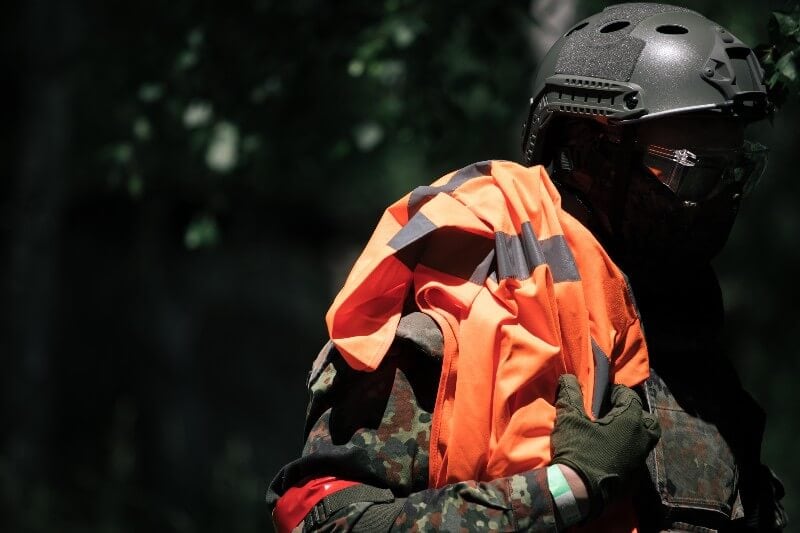
Airsoft is an exciting sport that appeals to many, including children. However, its nature—using realistic-looking firearms and projectiles—raises concerns regarding younger players. Here’s what you should consider if you’re considering introducing a child to airsoft.
Recommended Age Limits
- Manufacturer’s Recommendations: Many airsoft guns have age recommendations printed on the packaging, typically suggesting use for ages 18 and up. However, this is mostly from a liability standpoint and not necessarily a hard and fast rule.
- Field and Event Restrictions: Most established airsoft fields have age limits. Many will allow players as young as 12, though those under 16 or 18 will usually require parental consent and, in some cases, direct parental supervision.
- Physical and Emotional Maturity: Beyond official age limits, it’s crucial to consider the child’s physical and emotional maturity. Can they handle the weight and complexity of an airsoft gun? More importantly, can they understand and respect the safety rules, handle the pain of being hit, and maintain composure under pressure?
Extra Precautions for Younger Players
- Full Face Protection: While some adult players might opt for goggles only, it’s advisable for children to use full-face masks. This ensures protection for their eyes, teeth, and face, which might be more susceptible to injury.
- Additional Padding: Younger players might feel the sting of a BB more acutely due to their smaller size. Padded clothing or specially designed airsoft gear can provide extra protection.
- Lower-Power Guns: For children new to the sport, consider starting them off with a spring-powered pistol or another low-power airsoft gun. This allows them to get a feel for the game without the risk associated with more powerful electric or gas guns.
- Close Supervision: Always supervise younger players, whether it’s by playing alongside them or observing from the sidelines. This ensures they follow safety rules and helps guide them if they’re unsure about something.
- Education: Before allowing a child to play, ensure they understand the rules, the importance of protective gear, and how to operate their gun safely. This can’t be stressed enough. A well-informed young player is far less likely to have accidents.
- Physical Preparations: Make sure the child is aware of the potential pain associated with getting hit, and perhaps even let them experience a test shot in a controlled environment to gauge their reaction.
- Set Boundaries: If playing outside an established field, set clear boundaries to ensure children don’t wander into unmonitored areas where they might inadvertently threaten others or themselves.
While children can safely enjoy airsoft, it requires extra precautions and a firm commitment to safety protocols. With the right guidance, supervision, and equipment, younger players can have a fun and enriching experience in the airsoft world.
Tips to Minimize the Pain
Airsoft is a thrilling sport, but getting hit by a BB, especially at close range or in sensitive areas, can be uncomfortable. To ensure that you and other players have a fun and pain-minimized experience, consider these essential tips:
1. Adjusting Shooting Distance
- Mind the Minimum Engagement Distance (MED): Many airsoft fields implement a MED, the closest distance you can shoot someone from. Always respect this rule, as it’s designed to reduce the pain of close-up shots.
- Use a Secondary for Close Encounters: If you’re using a high-powered primary weapon, switch to a secondary weapon like a pistol for close-quarter battles. This ensures less powerful shots at close range.
2. Choosing the Right Ammo and Gun Type
- BB Weight: Heavier BBs (e.g., 0.28g and above) tend to hit harder than lighter ones (like 0.20g). If you’re looking to reduce the impact, opt for lighter BBs, but remember that wind might affect them more and may not be as accurate at long distances.
- Spring vs. Electric vs. Gas: Spring-powered guns generally have a lower power output than electric (AEG) or gas-powered guns. For casual play or if you’re new to the sport, a spring-powered gun might be a gentler introduction.
- Adjustable Velocity: Some advanced AEGs and gas guns allow players to adjust the muzzle velocity. Consider dialing back the power if you’re playing in a more casual setting.
3. Proper Game Etiquette
- No Over-shooting: Once you’ve hit a player and they’ve called their hit, there’s no need to keep firing. Overshooting is against the rules in many fields and can cause unnecessary pain.
- Avoid Headshots: While sometimes unavoidable, always aim for the torso or other large areas if possible. A BB to the head, especially the face, is much more painful than one to the chest or legs.
- Call Your Hits: Part of the honor system in airsoft is admitting when you’ve been hit. This displays integrity and prevents you from getting shot multiple times because opponents think you’re still in play.
- Communicate: If someone is repeatedly causing unnecessary pain, whether from close-range shots, over-shooting, or using excessively powerful guns, communicate with them calmly and constructively. Sometimes, players might not realize the impact of their actions, and a polite conversation can make all the difference.
In essence, minimizing pain in airsoft revolves around respect—for the rules, the equipment, and, most importantly, fellow players. With the right precautions and approach, everyone can enjoy the game and its strategic challenges without discomfort.
Managing the After-Effects
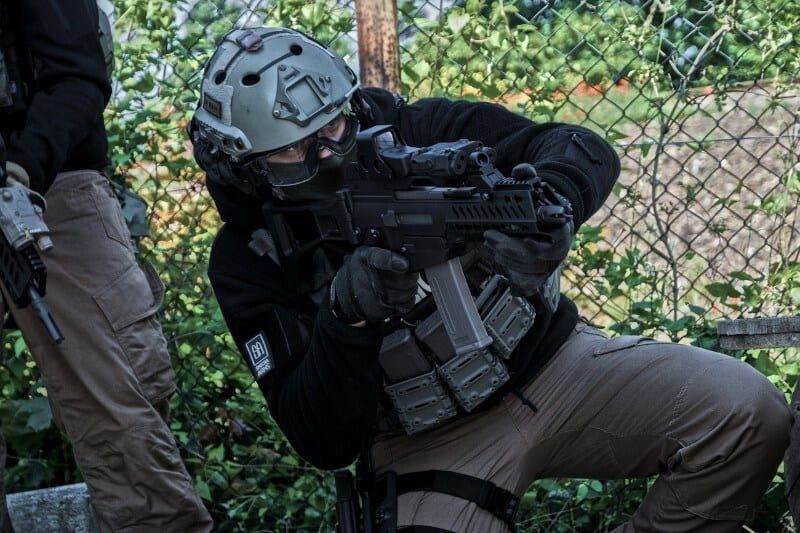
Even with all precautions, airsoft can sometimes result in bruises, welts, or other minor injuries. Understanding how to treat these and emphasizing post-game care can ensure quicker recovery and readiness for the next game day.
1. Typical Injuries and Their Treatments
- Bruises and Welts: These are the most common after-effects of being hit by an airsoft BB. They result from the force of the BB, causing small blood vessels (capillaries) to break.
- Treatment: Apply a cold compress immediately after the game to reduce swelling. After 24 hours, switch to a warm compress to increase blood flow and promote healing. Over-the-counter pain relievers like ibuprofen can help reduce pain and inflammation.
- Scratches and Abrasions can result from moving through rough terrain or close-quarter engagements.
- Treatment: Clean the area with mild soap and water. Apply an antibiotic ointment and cover with a bandage to prevent infections.
- Sprains and Strains: The dynamic nature of airsoft games, especially on uneven terrains, can sometimes lead to sprains or muscle strains.
- Treatment: Follow the R.I.C.E. method – Rest, Ice, Compression, and Elevation. If pain persists, seek medical attention.
- Eye Irritation: In rare cases where a BB might sneak past your eye protection or if dirt gets into your eyes, irritation can occur.
- Treatment: Do not rub your eyes. Flush them with clean, cool water or an eye wash solution. If irritation persists or if vision is affected, seek medical attention immediately.
2. Importance of After-Game Care and Rest
- Hydrate: The adrenaline of the game can sometimes mask how much you’ve sweated. After playing, rehydrate with water or electrolyte drinks to aid recovery and prevent dehydration.
- Clean and Inspect: After the game, it’s essential to inspect your body for any welts, cuts, or injuries you might not have noticed during play. This allows for prompt treatment.
- Stretch: Just like any physical activity, doing some post-game stretching is beneficial. This can help alleviate muscle soreness and reduce the risk of cramps.
- Rest: Giving your body ample time to rest and heal is crucial. If you’ve sustained significant injuries, consider taking a break from airsoft until you fully recover.
- Gear Maintenance: While caring for your body, don’t forget your gear. Clean and store all equipment properly. This prolongs their lifespan and ensures that they function safely and efficiently during your next game.
While airsoft is inherently a safe sport, the physical exertion and nature of the game can lead to minor injuries. Proper post-game care is just as vital as pre-game preparations. Ensuring you manage the after-effects properly guarantees you remain in top shape for your next airsoft adventure.
Airsoft Myths Debunked
Like many other sports and hobbies, Airsoft is surrounded by myths and misconceptions, especially regarding pain and injuries. Let’s tackle some of the most common misunderstandings and separate fact from fiction.
1. Myth: Airsoft BBs Can Easily Break the Skin
Fact: While airsoft BBs can cause welts or bruises, especially when shot from close range or with a powerful gun, they rarely break the skin. The instances where they might be typically due to inappropriate use, like shattered BBs or modified guns.
2. Myth: Getting Hit by an Airsoft BB Feels Like a Bee Sting
Fact: This is a common description, but the sensation of being hit by a BB varies. Factors such as range, BB weight, gun type, and individual pain tolerance play a role. While some might describe it as a bee sting, others might liken it to a sharp pinch or snap from a rubber band.
3. Myth: Airsoft Injuries are Only Superficial
Fact: While most airsoft injuries are superficial, like welts or bruises, there are instances of more severe injuries. Eye injuries can be serious if players don’t use proper eye protection. Also, sprains, strains, or falls can lead to more than superficial injuries.
4. Myth: Heavier BBs are Always More Painful
Fact: Heavier BBs carry more kinetic energy and can hit harder, but they aren’t always more painful. The gun’s power, the range, and even the impact angle play significant roles in how much a hit will hurt.
5. Myth: Wearing Thick Clothing Will Fully Protect You from Pain
Fact: While thick clothing can help mitigate the sting of an airsoft BB, it’s not a guaranteed protection against all pain. High-powered guns or close-range shots can still be felt through thick clothing. Moreover, bulky clothing doesn’t replace the need for dedicated protective gear, especially for the face and eyes.
6. Myth: Kids Feel Airsoft Pain More than Adults
Fact: Pain is subjective and varies from person to person. While kids might have a different pain threshold than adults, it’s inaccurate to say they universally feel more pain from airsoft hits. Much depends on individual tolerance, the situation, and the protective gear used.
7. Myth: All Airsoft Guns Inflict the Same Amount of Pain
Fact: The “pain” factor can differ significantly between a spring-powered pistol and a high-end AEG or gas-powered rifle. Factors like gun power, mechanism, and the type of BBs used can all influence the impact’s intensity.
Airsoft can indeed cause some discomfort. Many myths exaggerate the pain or misunderstand the sport’s nuances. As with many things, education and personal experience are the best tools to understand and enjoy airsoft fully. By debunking these myths, potential players can approach the game with a more informed perspective and better preparedness.
Dos and Don’ts for Beginners
Stepping into the world of airsoft can be both exhilarating and daunting. Here’s a guide to ensure newcomers have an enjoyable experience while sidestepping common pitfalls.
Dos:
1. Do Wear Proper Protective Gear
- Always wear eye protection, preferably full-seal goggles or a mask. Consider a hat, gloves, and knee pads for added protection.
2. Do Research Before Buying Equipment
- Start with a reliable but not overly expensive airsoft gun. Speak with experienced players or staff at local fields for recommendations.
3. Do Familiarize Yourself with the Rules
- Each game mode and field may have its own set of rules. Knowing them not only helps in strategy but also ensures everyone’s safety.
4. Do Communicate with Teammates
- Airsoft is a team sport. Share information, call out enemy positions, and coordinate movements.
5. Do Respect All Players, Regardless of Skill Level
- Everyone was a beginner once. Good sportsmanship fosters a positive community.
6. Do Hydrate and Eat Properly
- Airsoft can be physically demanding. Stay energized and hydrated to keep fatigue at bay.
7. Do Check Your Equipment Before the Game
- Ensure your gun is functioning, batteries are charged, and you have enough BBs.
Don’ts:
1. Don’t Remove Your Eye Protection During a Game
- Eyes are vulnerable, and accidents can happen in a split second. Only remove or adjust eye protection in designated safe zones.
2. Don’t Overextend Yourself
- Pushing beyond your limits can lead to injury or fatigue. Play at a pace comfortable for you, especially in your first few games.
3. Don’t Blind Fire
- Always look down at your sights or along your barrel when firing. Blind firing (shooting without looking) is often prohibited and dangerous.
4. Don’t Call Out Hits for Other Players
- While it can be frustrating to think someone isn’t calling their hits, accusing others can escalate into arguments. Discuss an issue calmly between rounds or alert a referee if you believe there’s an issue.
5. Don’t Forget to Call Your Hits
- Airsoft operates on an honor system. When hit, raise your hand or gun and clearly announce you’re out.
6. Don’t Bring Realistic Replica Guns in Public
- Even though they’re not real firearms, they can be mistaken for them. Transport them in cases and only use them in designated areas.
7. Don’t Be Discouraged by Mistakes or Losses
- Everyone makes mistakes, especially when starting. Learn from them, and remember that the primary goal is to have fun.
Embarking on your airsoft journey with these dos and don’ts in mind will ensure a safe and enjoyable first game and pave the way for many more thrilling airsoft adventures.
Incorporating Pain into Game Strategy
While airsoft is primarily a game of skill, tactics, and teamwork, the apprehension of pain can also influence players’ decisions and movements. Understanding this can be a valuable tool in shaping game strategy.
Using the Fear of Pain to One’s Advantage:
1. Suppressive Fire: By maintaining continuous fire, even if not aiming to hit, players can pin opponents in place. The threat of potential pain can deter them from peeking or moving, allowing your team to advance or complete objectives.
2. Feints and Distractions: Use the fear of being shot to divert the enemy’s attention. Firing from one direction and flanking from another can catch opponents off-guard, as they may be too apprehensive to leave cover.
3. Ambushes: The sudden burst of BBs from a concealed position can cause a momentary freeze in opponents, both from surprise and the reluctance to rush into a hail of pellets.
Tactical Moves and Game Plans:
1. Controlled Aggression: Aggressively taking ground, when done methodically, can push the enemy back. The immediate threat of close combat and potential pain can force opponents to retreat, giving your team an advantage.
2. Use of Cover: Positioning yourself behind a solid cover can minimize exposed body parts. This reduces the chances of getting hit and leverages the opponents’ apprehension of advancing into potential fire.
3. Information Gathering: Instead of always shooting to hit, shoot to gauge reactions. If an opponent ducks or moves in a particular way in response to fire, their actions can provide clues about their numbers, weapons, or intentions.
4. Morale Play: Sometimes, the game isn’t just about shooting. Intimidating shouts, noises, or even the sound of a high-powered airsoft gun can create apprehension, making opponents second-guess their moves.
Conclusion
Readdressing the primary question, “Does airsoft hurt?” – the answer is multifaceted. Being hit by an airsoft pellet can be uncomfortable, and anticipating that discomfort can shape how players approach the game. However, this very aspect of airsoft adds a layer of realism and intensity that many players find appealing.
The key to truly enjoying airsoft lies in respecting its nature. Embracing the sport’s challenges, including the potential for pain, while always adhering to safety protocols ensures a thrilling yet secure experience.
Ultimately, airsoft is about camaraderie, strategy, and fun. As players immerse themselves in the game, they often find that the fear of pain diminishes, overshadowed by the excitement and joy of the game. So gear up, play safe, and dive into the exhilarating world of airsoft.
Frequently Asked Questions (FAQs)
How can I reduce the pain from airsoft pellets?
Several measures can help reduce pain:
- Wear thicker clothing or specialized airsoft attire.
- Use protective gear, including chest protectors, gloves, and padded vests.
- Maintain a safe distance; the closer the shot, the more it hurts.
- Opt for lower FPS (Feet Per Second) guns when starting out.
Is it legal for children to play airsoft?
The legality varies by country and even within regions of countries. There’s an age limit (often 18) to purchase in many places, but younger players can play with parental consent or supervision. Always check local regulations and field-specific rules.
Are there any long-term effects of being hit by airsoft BBs?
Generally, airsoft BBs don’t cause long-term physical effects if proper protective gear is worn. Most injuries are superficial. However, repeated exposure without protection can lead to bruises, welts, or, in rare cases, skin penetrations, which might lead to infections if not properly treated.
What’s the difference between airsoft and BB guns in terms of pain?
BB guns typically fire metal BBs at higher velocities than airsoft guns. As a result, getting hit by a BB from a BB gun can cause more significant pain and injury than an airsoft pellet. It’s crucial to never use a BB gun for skirmishing as they’re not designed for safe player-versus-player action.
How often do serious injuries occur in airsoft games?
Serious injuries in airsoft are relatively rare, especially when players use proper protective gear and follow safety protocols. The most common injuries are minor welts or bruises. Eye injuries are a risk if players do not use eye protection, which underscores the importance of always wearing safety goggles or full-face masks.
Can I play airsoft without any protective gear?
While it’s technically possible, it’s highly discouraged. The minimum protection should be eye protection, as BBs can cause severe eye injuries. Additional gear like face masks, gloves, and padded clothing can prevent painful hits and injuries to other body parts.
Are there specific airsoft guns recommended for beginners to minimize pain?
Spring-powered airsoft guns or electric guns (AEGs) with adjustable FPS settings can be a good start for beginners. These tend to have lower FPS than gas-powered guns, meaning their pellets hit with less force. Consulting with experienced players or store employees can also guide beginners to models known for their gentler impact.

